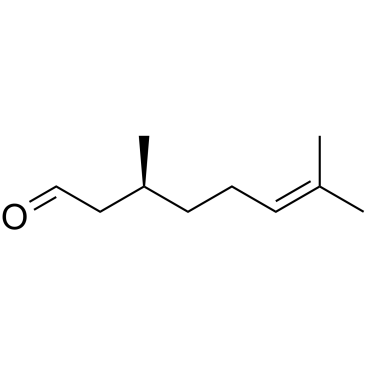(-)-citronellal

(-)-citronellal structure
|
Common Name | (-)-citronellal | ||
|---|---|---|---|---|
| CAS Number | 5949-05-3 | Molecular Weight | 154.249 | |
| Density | 0.8±0.1 g/cm3 | Boiling Point | 208.4±9.0 °C at 760 mmHg | |
| Molecular Formula | C10H18O | Melting Point | N/A | |
| MSDS | Chinese USA | Flash Point | 75.6±0.0 °C | |
| Symbol |

GHS07 |
Signal Word | Warning | |
|
Circuit formation and function in the olfactory bulb of mice with reduced spontaneous afferent activity.
J. Neurosci. 35(1) , 146-60, (2015) The type of neuronal activity required for circuit development is a matter of significant debate. We addressed this issue by analyzing the topographic organization of the olfactory bulb in transgenic mice engineered to have very little afferent spontaneous ac... |
|
|
Evaluation of the masking of dimethyl sulfide odors by citronellal, limonene and citral through the use of trained odor sensor mice.
Chem. Senses 38(1) , 57-65, (2013) Previous studies indicate that the most common result of mixing two odors is the decreased olfactory perception of one or both components in the mixture. An excellent example of this phenomenon is provided by the masking of an unpleasant odor by a pleasant od... |
|
|
On the synergistic catalytic properties of bimetallic mesoporous materials containing aluminum and zirconium: the Prins cyclisation of citronellal.
Chemistry 17 , 2077-88, (2011) Bimetallic three-dimensional amorphous mesoporous materials, Al-Zr-TUD-1 materials, were synthesised by using a surfactant-free, one-pot procedure employing triethanolamine (TEA) as a complexing reagent. The amount of aluminium and zirconium was varied in ord... |
|
|
Characterization of biofumigated Ralstonia solanacearum cells using micro-Raman spectroscopy and electron microscopy.
Phytopathology 102(1) , 105-13, (2012) Essential oils of palmarosa, lemongrass, and eucalyptus have shown promise as biofumigants for control of the bacterial wilt disease of edible ginger (Zingiber officinale) caused by Ralstonia solanacearum race 4 in previous potting medium studies. Biochemical... |
|
|
Influence of extraction methodologies on the analysis of five major volatile aromatic compounds of citronella grass (Cymbopogon nardus) and lemongrass (Cymbopogon citratus) grown in Thailand.
J. AOAC Int. 95(3) , 763-72, (2012) This paper deals with the systematic comparison of extraction of major volatile aromatic compounds (VACs) of citronella grass and lemongrass by classical microhydrodistillation (MHD), as well as modern accelerated solvent extraction (ASE). Sixteen VACs were i... |
|
|
Citronellal ingestion decreases the appeal of male mouse urinary pheromone for female mice.
Biosci. Biotechnol. Biochem. 76(9) , 1781-4, (2012) To determine whether ingestion of citronellal decreases the attractive power of the male mouse urinary odor, female mice were used in preference tests. A series of tests revealed that the female mice preferred voided urine odors from aged mice over those from... |
|
|
In vitro larvicidal activity of geraniol and citronellal against Contracaecum sp (Nematoda: Anisakidae).
Braz. J. Med. Biol. Res. 42(10) , 918-20, (2009) Human infection with fish parasites can result from the ingestion of incompletely cooked or raw fish, giving origin to parasitic diseases such as anisakiasis, caused by parasites of the Anisakidae family. The present study assessed the in vitro larvicidal eff... |
|
|
Anti-inflammatory and redox-protective activities of citronellal.
Biol. Res. 44(4) , 363-8, (2011) The anti-inflammatory and redox protective effects of the citronellal (CT) were evaluated using in vivo and in vitro tests. Intraperitoneal (i.p.) administration of CT (50, 100, and 200 mg/kg) inhibited (p < 0.05) the carrageenan-induced leukocyte migration t... |
|
|
Synthesis of all the stereoisomers of 6-methyl-2-octadecanone, 14-methyl-2-octadecanone, and 6,14-dimethyl-2-octadecanone, sex pheromone components of the Lyclene dharma dharma moth, from the enantiomers of citronellal.
Biosci. Biotechnol. Biochem. 76(10) , 1943-51, (2012) The enantiomers of citronellal were converted to all the stereoisomers of 6-methyl-2-octadecanone, 14-methyl-2-octadecanone, and 6,14-dimethyl-2-octadecanone, the female-produced sex pheromone components of the Lyclene dharma dharma moth. Three well-establish... |
|
|
Chemical composition analysis of the essential oil of Melissa officinalis L. from Kurdistan, Iran by HS/SPME method and calculation of the biophysicochemical coefficients of the components.
Nat. Prod. Res. 26(2) , 152-60, (2012) The volatile constituents of the essential oil of wild Melissa officinalis L. obtained from the Kurdistan province of Iran were extracted by headspace/solid-phase micro-extraction and were analysed by gas chromatography and gas chromatography/mass spectrometr... |